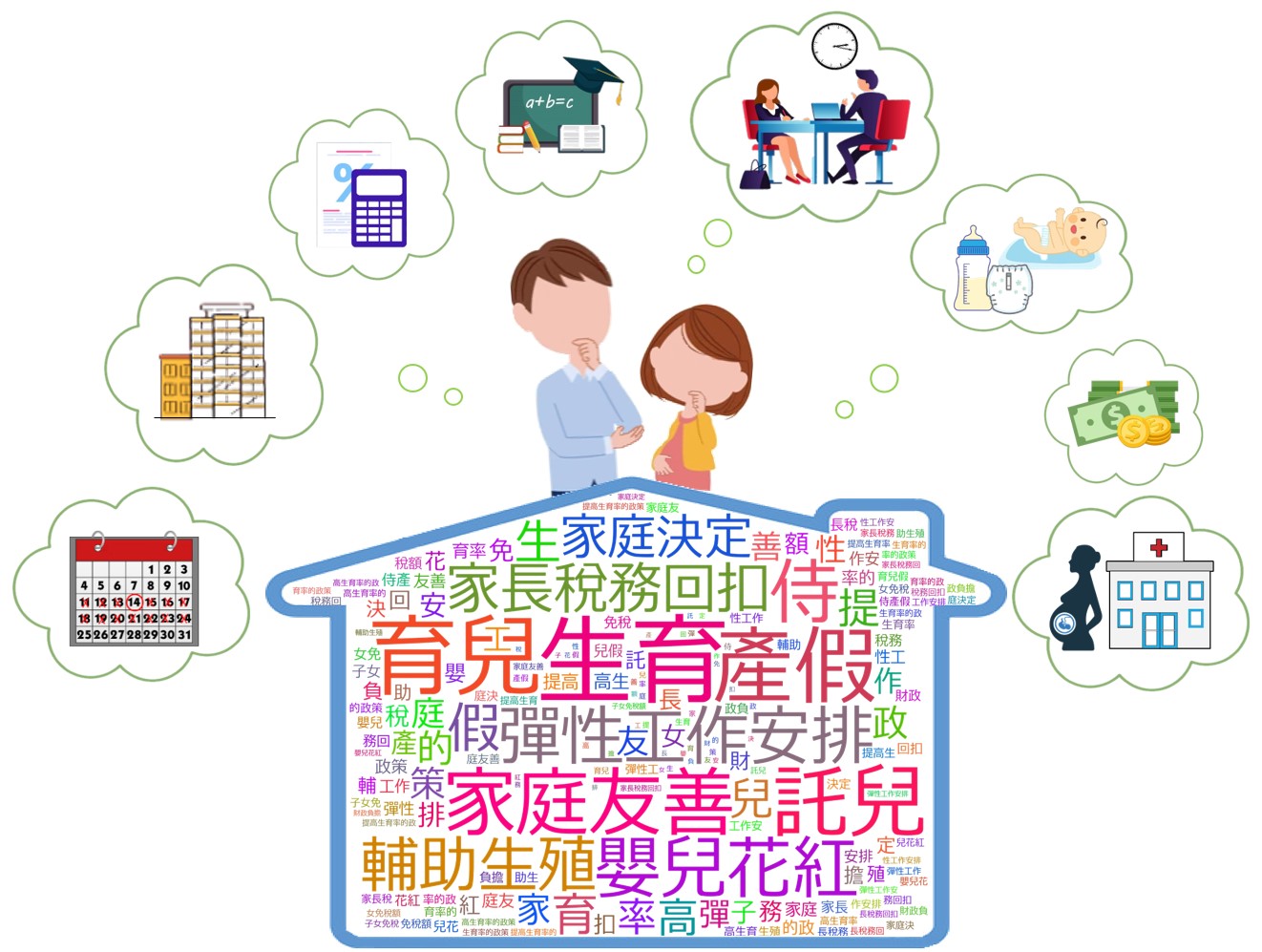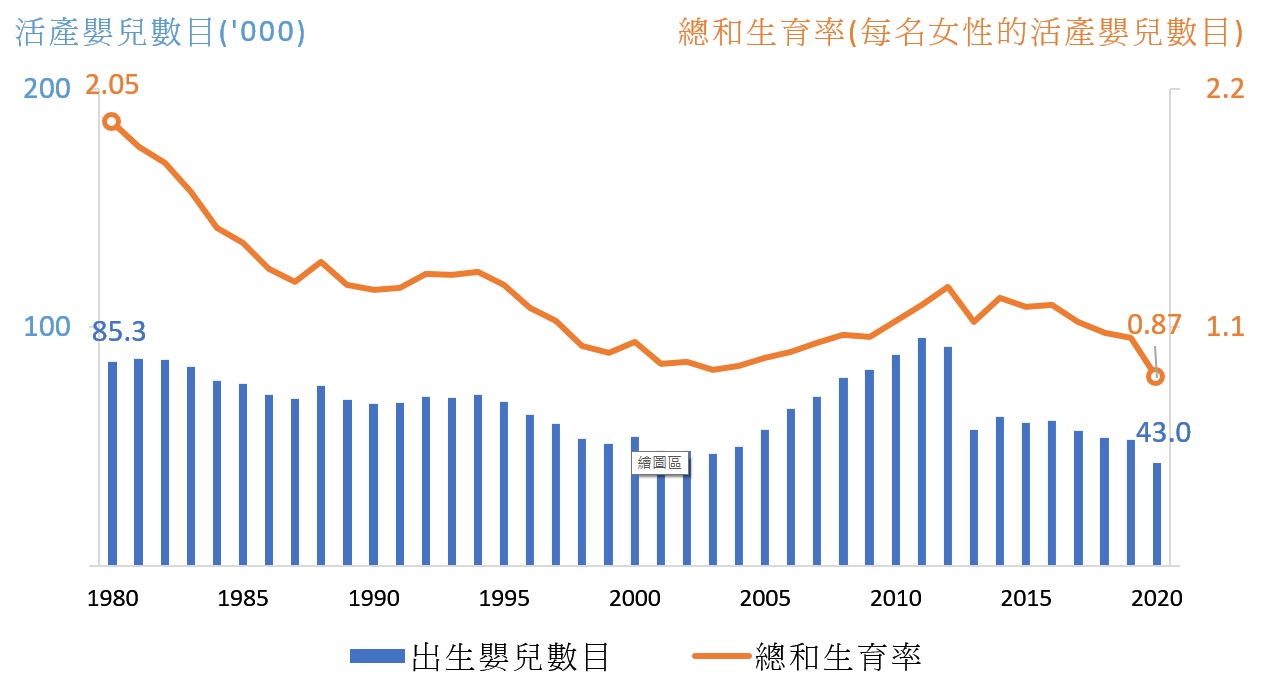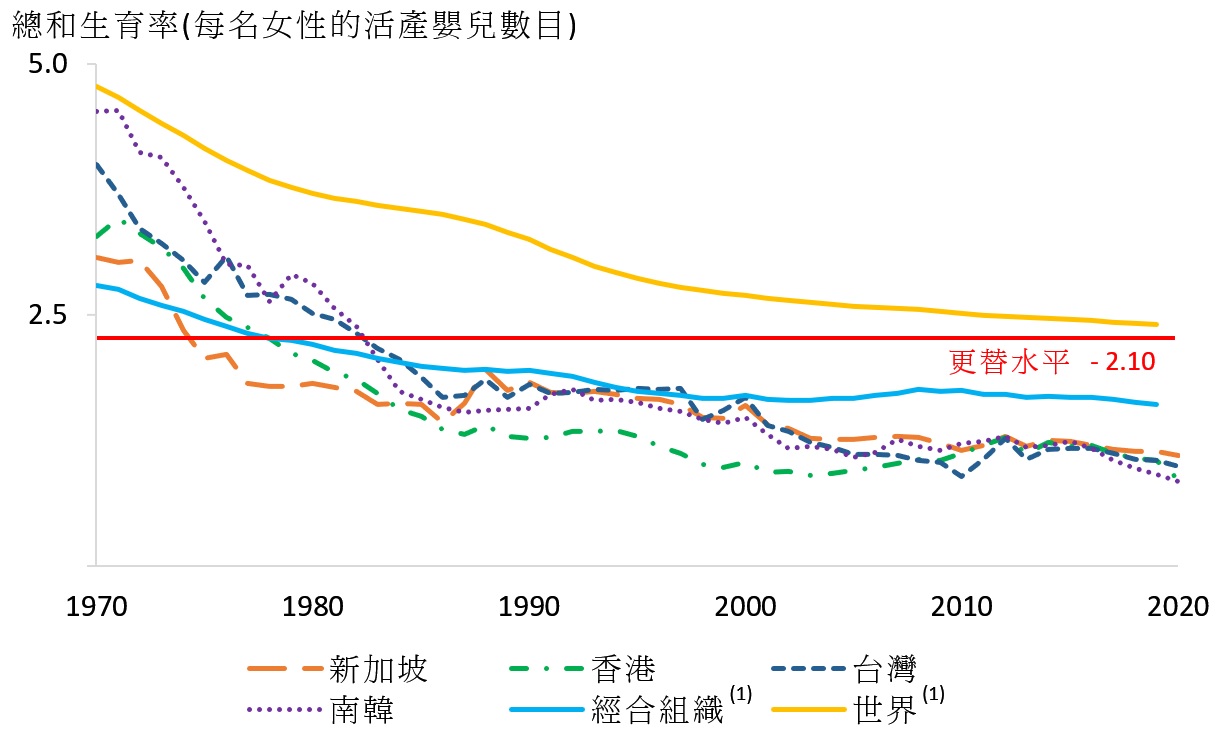ISE21/20-21
| 主題: | 人口政策、兒童及家庭支援、生育 |

- 香港嬰兒出生數目於2020年錄得19%的雙位數字按年跌幅,全年僅得43 000名新生嬰兒,為過去60年的最低水平。而總和生育率(即每名婦女在整個生育年齡周期的平均生育子女數字)更降至0.87的歷史低位,亦接近全球生育率最低水平的地方。1註釋符號代表總和生育率量度每名婦女在整個生育年齡周期中(即15-49歲),生育子女的平均數目。請參閱Census and Statistics Department (2020a及2021a)。 社會上因而存在意見,認為在面對日益嚴峻的人口挑戰下,政府有必要效法亞洲其他先進地方,推出嶄新措施鼓勵生育。2註釋符號代表Yip, P.S.F. (2014)、Lui, C.W.L. (2019)及Youth I.D.E.A.S. (2018)。
- 近年生育率下降,雖然部分或可歸因於社會事件及2019冠狀病毒病疫情("新冠疫情"),但較深層次的社會經濟問題亦是主要成因。偏低生育率將對本地社會結構和經濟帶來深遠影響,包括導致本地勞動人口在未來20年明顯收縮約150 000人或4%。3註釋符號代表Census and Statistics Department (2020c)。 過去5年,立法會議員曾至少5次討論鼓勵生育的議題。4註釋符號代表議員曾分別在2017年3月及11月的立法會會議上,各提出一項相關質詢;其後又在2020年7月立法會審議《2019年僱傭(修訂)條例草案》、2021年5月辯論有關設立"新生代基金"的議員議案,以及2021年6月的行政長官答問會期間,多次討論相關議題。請參閱GovHK(2017a及2017b)。
- 為了支援有意生育的夫婦,政府自2015年起推出更多家庭友善措施,例如增加侍產假及產假日數、提高子女免稅額,以及加推資助幼兒照顧名額等。環顧全球,約55個先進地方已推出鼓勵生育的政策,而新加坡的相關政策更被譽為於亞洲中"最為全面",因此具有一定參考價值。5註釋符號代表United Nations Population Division (2015)。 本期《資訊述要》首先回顧本港近期生育趨勢、支持生育政策及關注事項,繼而討論新加坡的鼓勵生育措施。
香港的近期生育趨勢及育兒友善政策
- 2020年本地生育率降至歷史低位:自1960年代起,香港的活產嬰兒數目大致呈下跌趨勢,期間僅在2001-2012年曾出現短暫回升。這個反彈始於終審法院於2001年7月裁定,內地公民在香港所生的嬰兒擁有居留權;但當特區政府宣布丈夫為非香港居民的內地孕婦,自2013年1月起在港分娩服務實施零配額政策後,本港出生嬰兒數目重拾跌軌。6註釋符號代表該等中國公民所生嬰兒在活產嬰兒總數的比例,由2001年的1.3%激增至2011年37.4%的最高位,其後逐步回落至2020年的0.5%。請參閱Census and Statistics Department (2021b)。
- 1980-2020年期間,本地新生嬰兒數目累計銳減49%(圖1)。具體而言,本港在2020年只有43 000名嬰兒出生,這不僅是60年來的最低數字,亦是歷來首次出現出生人數低於死亡人數(即49 800)的情況。總和生育率因而在40年間減半至僅0.87,同為本港紀錄新低,並只稍高於南韓同年錄得的0.84(後者於2019年為全球217個地方中總和生育率排名最低)。7註釋符號代表Census and Statistics Department (2021a)及World Bank (2021)。
圖1 - 1980-2020年期間的活產嬰兒數目及總和生育率

- 社會經濟背景:生育率偏低的主要成因,本港社會已有廣泛討論,概述如下。首先,本地女性普遍遲婚,女性初婚年齡中位數於1981-2020年期間,由24歲顯著上升至30歲。此外,選擇獨身的女性亦呈上升趨勢,40-44歲女性人口中從未結婚者所佔比例,亦因而於1981-2020年期間由3%躍增約5倍至近19%。8註釋符號代表Census and Statistics Department (2020a及2021c)。 其次,本港據稱工作節奏急促,職場制度僵化,僱員承受極大壓力。根據國際調查,香港是全球"過勞人口"最多的城市,導致育兒障礙。9註釋符號代表Kisi (2021)。 第三,本地育兒開支及由幼稚園至大學的教育成本高昂,研究指出相關成本可高達數以百萬計港元。10註釋符號代表Bauhinia Foundation Research Centre (2014)。 第四,香港居住環境擠迫,而且房屋開支負擔沉重,不利生育計劃。本港現時人均居住面積只有15平方米,位處全球最低之列。11註釋符號代表Census and Statistics Department (2018)。 第五,社會亦有意見,認為家務分工出現性別不平等,加上針對具生育意願和育兒責任的婦女的職場歧視,削弱了她們生兒育女的念頭。12註釋符號代表Chen, M. and Yip, P.S.F. (2017)及Rindfuss, R.R. and Choe, M.K. (2015)。
- 負面影響:生育率不斷下降,不單令人口老化趨勢惡化,亦令本地勞動市場更為依賴外地來港的適齡工作人士。根據政府統計處早前的推算,65歲及以上的人口比例會由2019年的18%,於20年間幾乎倍增至2039年的33%。而勞動人口與2018年頂峰相比,到2040年將累計萎縮約4%或逾15萬人。13註釋符號代表Census and Statistics Department (2020b及2020c)。 勞動投入減少或會拖慢經濟增長的步伐,窒礙社會實現投放更多資源改善民生的期望。
- 鼓勵生育的現行措施:政府於2015年檢討人口政策後,認為生兒育女乃"家庭的重要決定",而"政府過分干預未必恰當"。當局進一步指出,單憑政府政策難以"根本性扭轉低生育率的趨勢"。14註釋符號代表GovHK (2017b)及Chief Secretary for Administration's Office (2015)。 儘管如此,政府近年推行多項額外措施,為有意生育的夫婦提供育兒支援,當中包括:(a)2019年將侍產假增至5天;(b)2020年將產假增至14星期;(c)2015-2021年期間,將薪俸稅下的子女免稅額累增20%至每名120,000 港元;(d)自2020年起,就幼兒中心的服務費用,提供每月600 港元的津貼;及(e)2015-2020年期間,將資助幼兒照顧名額累增21%至33 000個。15註釋符號代表獲政府資助的獨立幼兒中心及附設於幼稚園的幼兒中心的總和。
- 關注事項:然而,部分論者認為上述措施過於温和,不足以大幅提高生育率。就子女免稅額而言,所節省的稅款對於身處較低稅階的家庭作用有限,更遑論在稅網之外的家庭。至於侍產假及產假日數,仍遠低於經濟合作與發展組織("經合組織")1.4星期及18.1星期的相應平均水平。16註釋符號代表Organisation for Economic Co-operation and Development (2019)。 此外,由於不少家庭友善僱傭政策(例如彈性工作時間及育兒假)並非法定要求,在職父母通常難以在工作與家庭之間取得理想平衡。17註釋符號代表Leung, L.C. (2016)。 儘管政府近年加強提供幼兒照顧服務,但三歲以下嬰幼兒的照顧服務名額,仍短缺最少3萬個。18註釋符號代表Legislative Council Secretariat (2019)。 針對需要輔助生殖科技服務的夫婦,他們須輪候極長時間,方可獲得公立醫院提供的受資助服務(例如,初診輪候時間長達11-34個月),19註釋符號代表GovHK (2017a)、Assisted Reproductive Technology Unit (2021)及Centre of Assisted Reproduction and Embryology (2021)。 否則便要考慮改為接受私營機構費用高昂的服務。20註釋符號代表輔助生殖科技治療包括人工授精、體外受精及冷藏胚胎移植等。香港私營機構提供體外受精服務的收費,每個療程可高達10萬港元以上。 有鑒上述不足,不少學者及關注團體要求政府檢討本地生育政策。21註釋符號代表Yip, P.S.F. (2014)、Lui, C.W.L. (2019)及Youth I.D.E.A.S. (2018)。
新加坡的生育政策及育兒友善政策
- 綜觀全球55個明確訂立鼓勵生育政策的地方,其具體措施存在不少共通之處(包括提供財政及稅務誘因、給予法定育兒假期、實施彈性工作安排,以及提供託兒服務),惟細節則各有不同。22註釋符號代表55個地方之中,27個位於歐洲(包括法國和德國),18個位於亞洲(包括新加坡和日本)。請參閱United Nations Population Fund (2019)。 因應上述本地的關注事項,下文扼要論述新加坡的生育措施。
- 新加坡的總和生育率,曾在1960年達到5.76的高位。其後由於當地急速工業化,婦女工作機會大增,總和生育率穩步下跌。1975年,總和生育率更跌至2.07(即低於更替水平),新加坡政府遂陸續推出多項提高生育率及育兒友善措施。23註釋符號代表Jones, G.W. and Hamid, W. (2015)。 部分措施被視為頗具特色,現扼述如下:
(a) "嬰兒花紅現金獎勵計劃"下的特別資助:自2001年4月起,誕下第1名及第2名新生嬰兒的父母可獲8,000 新加坡元(46,560 港元)的一次性現金獎勵,於18個月內分5期發放。第3名及其後的每名新生嬰兒,生育獎金更增至10,000 新加坡元(58,200 港元),以累進資助方式鼓勵增加子女數目。24註釋符號代表Ministry of Social and Family Development (2021)。 此外,政府亦設立共同儲蓄計劃(名為"兒童發展戶口"),先行存入3,000 新加坡元(17,460 港元)作為前期資金。在子女年滿12歲前,父母於該戶口存入的款項,政府會作出等額配對供款,惟供款額設有上限,並同樣地按家庭子女數目而遞增;25註釋符號代表新加坡政府作出配對供款的上限如下:第1名子女3,000 新加坡元(17,460 港元),第2名子女6,000 新加坡元(34,920 港元),第3名及第4名子女增至9,000 新加坡元(52,380 港元),第5名及以上子女15,000 新加坡元(87,300 港元)。 (b) "家長稅務回扣"下的誘因:新加坡現存兩項有別於香港的育兒稅務誘因。首先,除子女免稅額外,新加坡的父母在第1名子女出生的年度,可從應繳稅款中獲5,000 新加坡元(29,100 港元)的一次性"家長稅務回扣"。26註釋符號代表第2名子女的家長稅務回扣限為10,000 新加坡元(58,200 港元),第3名及以上子女則為20,000 新加坡元(116,400 港元)。請參閱Inland Revenue Authority of Singapore (2021a)。 此外,所有在職母親均可申領"在職母親子女評稅扣減",在計算個人入息稅時,就第1名子女豁免計算15%的收入;27註釋符號代表根據在職母親子女評稅扣減,育有第2名子女的在職母親可獲豁免計算20%的收入,育有第3名及以上子女者,獲豁免計算25%的收入。請參閱Inland Revenue Authority of Singapore (2021b)。 (c) 較長的育兒假期:新加坡的在職母親自2008年起可享有長達16星期的有薪產假;而在職父親亦自2017年起可享有2星期的有薪侍產假。28註釋符號代表經雙方同意後,在職父親可分享妻子的產假,上限為4星期,以作為共同育兒假。請參閱Ministry of Manpower (2021b及2021c)。 此外,新加坡的父母在子女滿7歲前,每年可放取最多6天的有薪育兒假;至於育有2歲以下子女的父母,亦可每年放取最多6天的無薪育嬰假;29註釋符號代表Ministry of Manpower (2021a及2021d)。 (d) 更為慷慨的託兒資助:若父母將子女送往持牌託兒中心照顧,他們可獲發基本學前教育資助:年齡介乎2-18個月的嬰幼兒,每月資助額最多為600 新加坡元(3,490 港元);18-72個月的較年長兒童,每月資助額最多為300 新加坡元(1,750 港元)。30註釋符號代表每月收入低於限額(12,000 新加坡元或69,840 港元)的家庭,可獲額外資助,上限為每月710 新加坡元(4,130 港元)。請參閱Government of Singapore (2020b)。 為了向父母提供可負擔的託兒服務,新加坡政府於2021-2025年期間向超過320家私營託兒中心提供資助。31註釋符號代表相關經營者須將全日制託兒服務及嬰幼兒照顧服務的每月收費,分別維持在低於760 新加坡元(4,420 港元)及1,330 新加坡元(7,740 港元)的水平。請參閱Early Childhood Development Agency (2020)。 這項政策旨在把資助學前教育學童覆蓋率,由2019年的僅50%,顯著提升至2025年或之前的80%; (e) 資助企業提供靈活工作安排:自2013年起,新加坡企業若向僱員提供靈活工作安排(例如彈性職務分配或彈性上班時間),可向政府申請"工作與生活和諧津貼",以彌補相關開支。就每名定期使用靈活工作安排的僱員,企業可獲發每年2,000 新加坡元(11,640 港元)的津貼,而兩年合計的津貼總額上限為70,000 新加坡元(407,400 港元)。不過,由於最近新冠疫情爆發,導致靈活工作安排的使用量激增,新加坡政府已於2020年8月暫停接受該項津貼的新申請;32註釋符號代表新冠疫情爆發後,領取工作與生活和諧津貼的受惠對象在2020年4-8月期間急增,涵蓋約8 000家公司逾9萬名僱員。請參閱Ministry of Manpower (2020)。 (f) 有意生育的父母可獲房屋優先權:在育兒優先配屋計劃下,懷孕中及已有1名子女的新婚夫婦可獲優先權,購買資助出售房屋單位。33註釋符號代表Housing and Development Board (2021b)。 同樣地,已育有至少3名子女的家庭,可在第三名子女優先配屋計劃下獲得優先權。34註釋符號代表Housing and Development Board (2021c)。 此外,打算在3個月內結婚的準夫婦,亦可在未婚夫妻住房計劃下購買資助房屋;35註釋符號代表Housing and Development Board (2021a)。 及 (g) 提供更多輔助生殖科技的支援:對於需要輔助生殖科技的夫婦,新加坡政府提供更多支援。在公營輔助生育中心接受輔助生殖科技程序的夫婦,最多可獲新加坡政府共同支付75%的費用,而輪候時間亦僅為2-6星期。36註釋符號代表Government of Singapore (2020a)及Ministry of Health (2020)。 - 對育有兩名子女的新加坡家庭而言,當孩子年滿13歲時,其累計經濟誘因估計可多達118,000 美元(915,900 港元)。37註釋符號代表United Nations Population Divisions (2015)。 在豐厚的育兒福利下,新加坡於2001-2017年期間用於支援婚姻和生育的年度公共開支,躍增4倍至25億新加坡元(141 億港元)。38註釋符號代表Koh, C.Y. (2018)。 聯合國因此讚揚新加坡的鼓勵生育政策,在芸芸亞洲地方中"最為全面"。
- 然而,即使當地舉措看似涵蓋周全,但聯合國亦察悉新加坡是"世界上生育率最低的地方之一"。2020年,新加坡的總和生育率只有1.10,遠低於經合組織1.61的平均數字,亦僅略高於香港(圖2)。針對這矛盾現象,存在不同解讀。一方面,部分學者仍對新加坡的生育政策稱譽有加,認為倘若沒有相關措施,總和生育率或會進一步下跌10%-25%。39註釋符號代表Jones, G.W. and Hamid, W. (2015)。 另一方面,亦有專家持相反意見,認為"沒有明確證據"證明新加坡的鼓勵生育措施奏效。40註釋符號代表Jones, G.W. and Hamid, W. (2015)。 與此相呼應,聯合國指出現時難以使用客觀證據,來釐清和評估不同生育政策的具體影響,因為該等政策與社會上的"宏觀制度和文化背景",有着不可分割的關係。41註釋符號代表United Nations Population Fund (2019)。
圖2 - 1970-2020年期間新加坡與其他選定地方的總和生育率

| 註: (1) | 截至2019年的最新數字。 |
| 資料來源: | Department of Statistics Singapore (2021)、Census and Statistics Department (2021a)、Ministry of Labor (2021)、Statistics Korea (2021)、Organisation for Economic Co-operation and Development (2021)及World Bank (2021)。 |
結語
- 有鑒本地生育率持續下跌,社會上存在持續倡議,要求政府推出更多鼓勵生育措施。雖然新加坡的生育措施頗為積極,並被譽為於亞洲中"最為全面",但其生育率卻不較其他亞洲地方特別優勝。部分論者認為,新加坡的舉措未能扭轉生育率跌勢,但亦有論者表示若非該等措施的提振作用,當地生育率甚且會跌至更低水平。
立法會秘書處
資訊服務部
資料研究組
林昇陽
2021年8月4日
附註:
參考資料:
| 香港
| |
| 1. | Assisted Reproductive Technology Unit. (2021) Public Service Appointment.
|
| 2. | Bauhinia Foundation Research Centre. (2014) Launch of the city's first comprehensive Child Cost Calculator.
|
| 3. | Census and Statistics Department. (2018) 2016 Population By-census (Thematic Report: Persons Living in Subdivided Units).
|
| 4. | Census and Statistics Department. (2020a) Fertility Trend in Hong Kong, 1981 to 2019.
|
| 5. | Census and Statistics Department. (2020b) Hong Kong Population Projections 2020-2069.
|
| 6. | Census and Statistics Department. (2020c) Table E486: Hong Kong Labour Force Projections.
|
| 7. | Census and Statistics Department. (2021a) Table 3: Vital Events.
|
| 8. | Census and Statistics Department. (2021b) Table 4: Number of live births born in Hong Kong to Mainland women.
|
| 9. | Census and Statistics Department. (2021c) Women and Men in Hong Kong - Key Statistics (2021 Edition).
|
| 10. | Centre of Assisted Reproduction and Embryology. (2021) Contact Us.
|
| 11. | Chen, M. and Yip, P.S.F. (2017) The Discrepancy Between Ideal and Actual Parity in Hong Kong: Fertility Desire, Intention, and Behavior. Population Research and Policy Review, vol. 36, no. 4, pp. 583-605.
|
| 12. | Chief Secretary for Administration's Office. (2015) Population Policy: Strategies and Initiatives.
|
| 13. | GovHK. (2017a) LCQ8: Medical support for women in relation to child birth.
|
| 14. | GovHK. (2017b) LCQ15: Measures to encourage childbearing.
|
| 15. | Legislative Council Secretariat. (2019) Opportunities and challenges facing maternal workforce in Hong Kong.
|
| 16. | Leung, L.C. (2016) Making Policy for Child Care in Hong Kong.
|
| 17. | Lui, C.W.L. (2019) Family Policies, Social Norms and Fertility Decisions: A Survey Experiment.
|
| 18. | Rindfuss, R.R. and Choe, M.K. (2015) Diversity across Low-Fertility Countries: An Overview. Low and Lower Fertility, pp. 1-13.
|
| 19. | Yip, P.S.F. (2014) A Study of Aspiration of Fertility amongst Married Women in Hong Kong (Age 15-49).
|
| 20. | Youth I.D.E.A.S. (2018) Boosting Birth Rate in Hong Kong.
|
| 新加坡
| |
| 21. | Department of Statistics Singapore. (2021) Births And Fertility Rates, Annual.
|
| 22. | Early Childhood Development Agency. (2020) More Families to Benefit from Lower Fee Caps at 324 Childcare Centres Appointed as Partner Operators.
|
| 23. | Government of Singapore. (2020a) Co-Funding For Assisted Conception Procedures (ACP).
|
| 24. | Government of Singapore. (2020b) Subsidies For Preschool.
|
| 25. | Housing and Development Board. (2021a) Fiancé/Fiancée Scheme.
|
| 26. | Housing and Development Board. (2021b) Parenthood Priority Scheme (PPS).
|
| 27. | Housing and Development Board. (2021c) Third Child Priority Scheme (TCPS).
|
| 28. | Inland Revenue Authority of Singapore. (2021a) Parenthood Tax Rebate (PTR).
|
| 29. | Inland Revenue Authority of Singapore. (2021b) Working Mother's Child Relief (WMCR).
|
| 30. | Jones, G.W. and Hamid, W. (2015) Singapore's Pro-natalist Policies: To What Extent Have They Worked? Low and Lower Fertility, pp. 33-61.
|
| 31. | Koh, C.Y. (2018) Fertility Rebound in the OECD: Insights for Singapore.
|
| 32. | Ministry of Health. (2020) Extension of Assisted Conception Procedure Co-Funding to Private Assisted Reproduction Centres.
|
| 33. | Ministry of Manpower. (2020) Work-Life Grant (WLG) for flexible work arrangements.
|
| 34. | Ministry of Manpower. (2021a) Childcare leave eligibility and entitlement.
|
| 35. | Ministry of Manpower. (2021b) Maternity leave eligibility and entitlement.
|
| 36. | Ministry of Manpower. (2021c) Paternity leave.
|
| 37. | Ministry of Manpower. (2021d) Unpaid infant care leave.
|
| 38. | Ministry of Social and Family Development. (2021) Baby Bonus Scheme.
|
| 39. | United Nations Population Division. (2015) Do pro-fertility policies in Singapore offer a model for other low-fertility countries in Asia?
|
| 其他
| |
| 40. | Kisi. (2021) Cities with the Best Work-Life Balance 2021.
|
| 41. | Ministry of Labor. (2021) Fertility Rates of Childbearing Age Women.
|
| 42. | Organisation for Economic Co-operation and Development. (2019) PF2.1. Parental leave systems.
|
| 43. | Organisation for Economic Co-operation and Development. (2021) Fertility rates.
|
| 44. | Statistics Korea. (2021) Preliminary Results of Birth and Death Statistics in 2020.
|
| 45. | United Nations Population Fund. (2019) Policy responses to low fertility: How effective are they?
|
| 46. | World Bank. (2021) Fertility rate, total (births per woman).
|
資訊述要為立法會議員及立法會轄下委員會而編製,它們並非法律或其他專業意見,亦不應以該等資訊述要作為上述意見。資訊述要的版權由立法會行政管理委員會(下稱"行政管理委員會")所擁有。行政管理委員會准許任何人士複製資訊述要作非商業用途,惟有關複製必須準確及不會對立法會構成負面影響。詳情請參閱刊載於立法會網站(www.legco.gov.hk)的責任聲明及版權告示。本期資訊述要的文件編號為ISE21/20-21。